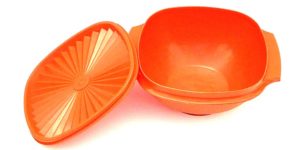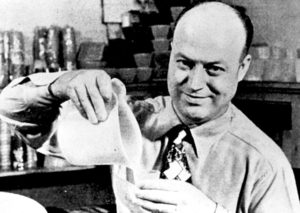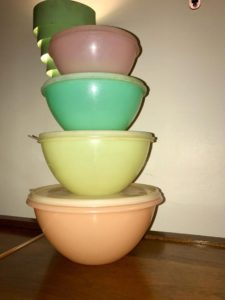
We Boomers are proud of the fact that we came into existence within a few years of the end of WWII. And as the nation put all of the creative efforts that were once channeled into making the world safe for democracy into business ventures, many familiar household names sprung up during this time as well.
One of the most familiar monikers is that of one Earl Tupper. It was he who devised plastic containers for food storage that featured a delightful operation known as “burping.”
Tupper started out in the landscaping/nursery business. He did well for a while, until the Great Depression came along. Like millions of other Americans, he was forced into unemployment by the harsh economic times, and was fortunate to find a job with the DuPont Corporation.
He was given an assignment: find a use for worthless chunks of plastic slag that were left over from other the production of other products. He purified the slag and was then able to use it to form lightweight, durable implements for servicemen including bowls, glasses, plates, and even gas masks. Later, he developed sealable tops for containers by studying the lids of paint cans.
Tupper bailed from DuPont in 1938 and started his own company. He did okay while the war raged, but in 1946, the future of home food storage crossed paths with Tupper plasticware.
Tupper’s plastic containers with their distinctive resealable lids went on the market in 1946. He called on local hardware and department stores in an effort to convince them to begin carrying his products. A few years later, however, a monumental decision would be made that would put Tupperware into the lexicon of the English language, and also into 20th century culture.
A sales representative for Stanly Home Products by the name of Brownie Wise called Tupper up one day and gave an impassioned plea on the benefits of directly marketing his wares by means of home parties thrown by millions of housewives who would delight at the chance to make some income in those stay-at-home days.

Tupper was impressed with the contagious enthusiasm of West, and hired her on the spot as vice-president. The first thing she did was remove Tupperware from stores altogether.
Wise believed fervently in the spirit of homemakers, and put them to work putting on Tupperware parties. She sweetened the pot by creating annual jubilees in sunny Florida where Tupperware representatives would gather for a week’s worth of socializing, fellowship with other home representatives, and motivational speeches. There were also prizes galore given out.
The combination of an excellent product and the fun and profitability of the parties and the perks made Tupperware a household name during the 1950’s.

Brownie Wise made the cover of Business Week magazine in 1954, the first woman to do so. However, her growing celebrity status was a source of irritation to Tupper, who preferred quietly becoming wealthy to the spotlight, both for himself as well as his company.
In 1958, tensions between Tupper and Wise came to a head over the high cost of the jubilees, and she was fired. Soon afterwards, Tupper sold the company lock, stock, and barrel to Rexall Drugs for a cool sixteen million 1958 bucks. Tupper then renounced his US citizenship and moved to his own island in Costa Rica in order to avoid a crippling tax burden.
Tupperware proved to be an excellent investment for Rexall. They continued the home-sales-only approach, and thus many of us Boomer kids have fond memories of our mothers either attending or throwing Tupperware parties. The hosts were rewarded with Tupperware goodies of their own, and they could climb the ranks and take on managerial roles that would pay out real cash if they were so inclined.
Here in the 21st century, Tupperware is still around, but is at sort of a crossroads. Its product name is still highly respected, but it’s getting harder and harder to find Tupperware parties.
The company tried selling directly to Target stores, but this only resulted in angering representatives who now had to compete with a huge national chain. Additionally, sales were disappointing, causing much harm to the business model and the goodwill of its home-grown representative base. Additionally, cheap clones of genuine Tupperware abound, and the name isn’t as strong as it was when our mothers were aggressively marketing it at a time when you had to go to a party just to buy it.
So why not put out feelers of just who in your local community might be holding a Tupperware party and go check it out? It’s a part of our Boomer heritage that is in danger of disappearing altogether.
It would be sad if something as nice as a gathering of family, friends, and neighbors to obtain high-quality kitchen items was to vanish.